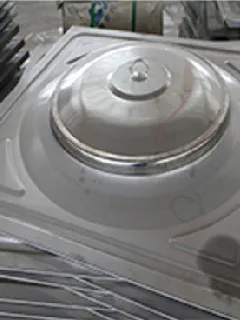loading...
- No. 9, Xingyuan South Street, Dongwaihuan Road, Zaoqiang County, Hengshui, Hebei, China
- admin@zjcomposites.com
- +86 15097380338
- Welcome to visit our website!
frp grating walkway
The Rise of FRP Grating Walkways A Modern Solution for Diverse Applications
In recent years, the significance of Fiber Reinforced Polymer (FRP) grating walkways has grown substantially due to their unique properties and versatility. Designed to provide safe and durable walking surfaces, FRP grating is increasingly being utilized across various industries and environments, making it a favored choice for architects, engineers, and contractors alike.
Understanding FRP Grating
FRP grating is composed of a matrix of glass or carbon fibers and polymer resin, which results in a lightweight, corrosion-resistant, and strong material. Unlike traditional steel grating, which can be subject to rust and degradation, FRP grating is designed to withstand harsh environmental conditions. This makes it an excellent choice for applications in chemical plants, wastewater treatment facilities, and marine environments where exposure to corrosive agents is a concern.
Benefits of FRP Grating Walkways
1. Corrosion Resistance One of the most significant advantages of FRP grating is its resistance to various chemicals, acids, and salts. This property not only contributes to its longevity but also reduces maintenance costs, as there is no need for regular painting or treatment, unlike metal alternatives.
2. Lightweight Construction Compared to steel or aluminum, FRP grating is considerably lighter. This characteristic not only facilitates easier transportation and installation but also minimizes structural load on buildings and existing frameworks, making it an ideal choice for retrofitting projects.
3. Safety Features The surfaces of FRP grating can be manufactured with anti-slip textures, significantly enhancing safety in high-traffic areas. This can be especially beneficial in industrial or outdoor settings where wet or oily conditions can pose a hazard.
4. Versatility in Design FRP grating comes in a variety of colors, shapes, and sizes. This flexibility allows architects and designers to incorporate it seamlessly into various design aesthetics while meeting specific functional requirements. Whether for a pedestrian walkway, a platform, or a stairway, FRP grating can be customized to fit any project.
frp grating walkway

5. Environmental Considerations As sustainability becomes a critical focus for many organizations, the use of FRP provides an environmentally friendly solution. The production of FRP can often involve less energy than traditional metal manufacturing, and its longevity contributes to reduced waste in the long term.
Applications of FRP Grating Walkways
The adaptability of FRP grating means it can be applied in a multitude of contexts
- Industrial Facilities Many manufacturing plants and industrial sites utilize FRP walkways to transport personnel safely. They are also commonly found near equipment and in areas where spills might occur.
- Marine Environments FRP grating is gaining traction in marine applications, such as docks and piers, where resistance to saltwater and moisture is crucial. Its lightweight nature simplifies installation in these floating structures.
- Transportation Transit stations and public transport systems can benefit from FRP walkways. The material’s durability and slip resistance enhance passenger safety while also reducing maintenance needs.
- Walking Paths in Parks Increasingly, FRP is being used in park design, providing eco-friendly pathways that are attractive and functional while blending harmoniously with natural surroundings.
Conclusion
In summary, FRP grating walkways represent an innovative and effective solution for various needs across numerous industries. Their unique advantages—corrosion resistance, lightweight construction, safety features, design versatility, and environmental friendliness—position them as a leading choice for modern architecture and construction. As businesses continue to recognize the benefits of this material, it is likely that the presence of FRP grating will become even more prevalent in diverse applications, enhancing safety and efficiency in everyday environments. Embracing this technology not only meets immediate functional requirements but also supports sustainable development goals, making FRP grating a smart choice for the future.
-
The Rise of FRP Profiles: Strong, Lightweight, and Built to LastNewsJul.14,2025
-
SMC Panel Tanks: A Modern Water Storage Solution for All EnvironmentsNewsJul.14,2025
-
GRP Grating: A Modern Solution for Safe and Durable Access SystemsNewsJul.14,2025
-
Galvanized Steel Water Tanks: Durable, Reliable, and Ready for UseNewsJul.14,2025
-
FRP Mini Mesh Grating: The Safer, Smarter Flooring SolutionNewsJul.14,2025
-
Exploring FRP Vessels: Durable Solutions for Modern Fluid HandlingNewsJul.14,2025
-
GRP Structures: The Future of Lightweight, High-Performance EngineeringNewsJun.20,2025
